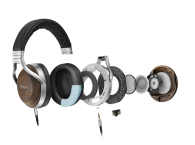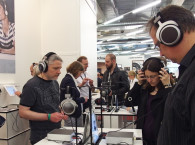
There clearly is too much discussion on this segment about the sound characteristics of headphones (e.g., frequency response curves) and not so much about differentiating the inherent features of specific drivers like planar magnetic or different design choices in dynamic drivers. And when there's a focus on drivers, as with with in-ears, there's far too much attention on the number of balanced armature drivers and not so much about how those are tuned and contribute to generate a coherent response. Plus, in my opinion, most manufacturers that target audio quality are not sensitive to key ergonomic and design aspects, which in a mass market are clearly main differentiators.
audioXpress is privileged to have on its team some of the world's leading experts in the field, and there's always a continuous exchange that goes on about what is there that is new, deserves praise or - sometimes - what is actually different, outstanding, or revolutionary. It is intriguing to hear about new headphones that set a new benchmark in "quality" - regardless of the price. Internally, on different occasions there was praise for the OPPO Digital PM-1 (and the affordable PM-3) and virtually all outstanding Tesla products from beyerdynamic, including the new Xelento remote in-ears. There was also praise for Grado, Audeze, and Audioquest, and of course a lot of talk about the new Sennheiser Orpheus system. But the list could go on and on.
The recent model that we heard "caused a stir" was the Sonoma Model One Headphone System, which apparently is now finally available ($4,995 retail). As Sonoma Acoustics details, the Model One was designed from scratch as a complete system - an audio chain - to deliver "unprecedented hi-res performance." The British company paid attention to every component and material choice, design considerations, and engineering aspect, targeting the highest performance possible.
The Model One is the first headphone system in the world to incorporate the High-Precision Electrostatic Laminate (HPEL) transducer developed and manufactured by Warwick Audio Technologies (WAT), combining Injected Magnesium Ear-Cups for low weight, superior acoustical damping, and RFI/EMI shielding. The Model One also features ear-pads and headband handmade from top-grain hair sheep leather, among other unique details. The electrostatic headphones are then complemented with a special ultra-low capacitance cable, developed in collaboration with Straight Wire, and a dedicated high-performance, discrete FET Class-A amplifier with USB, coax S/PDIF digital as well as RCA analog inputs. The USB input accepts all High-Resolution Audio formats up to 32-bit/384 kHz PCM and DSD via DoP (DSD64 and DSD128), while the S/PDIF input accepts all PCM formats up to 24-bit/192 kHz. Inside there is a ESS SABRE 32-bit Reference DAC chip, a custom 64-bit double-precision fixed-point DSP, a multi-channel 32-bit/384 kHz AKM Premium ADC, and a custom universal voltage switch-mode power supply. The Sonoma Model One System even ships with its special USB cable with gold-plated connectors, co-developed with Straight Wire.

From the existing published reviews and from the opinions I've heard from our own experts in the field and even some respected professionals in the recording community (it's important to highlight Sonoma's prior involvement in professional high resolution audio recording systems and DSD development), we now know what a high-quality headphone system can be. If anyone would need a reference in terms of quality, the Sonoma Model One Headphone System is it - even if it costs $5,000 USD. How relevant this is for anyone shopping for headphones to use daily with an iPhone and listen to Spotify? Not really. Very soon, someone could very well create a DSP preset to emulate the Model One response on any $200 headphone - if that would be a selling argument.
Manufacturers need to look at significant existing trends, such as the fact that we are now able to use active processing to "tune" the response of a headphone to our personal preferences - not only in general, but according to the environment where we listen. When we use headphones at home or in a plane, when we are totally relaxed or stressed out, our hearing changes, and our ability to deal with certain types of music, volume tolerance, and (yes) frequency sensitivity changes... Independently, if the headphones have the best "tuned" frequency response in the world, they will sound different to our ears on different occasions, and if we can do something to improve that... we do it. Soon, headphones - especially in-ears - will be able to measure some key hearing and environmental parameters and automatically adjust the response in terms of loudness and frequency response, with awareness of the surrounding noises, etc., directly in real time, at any moment. So, the "best headphones" will be those that feature drivers that will have the highest ability to translate a quality response within those variables.

Buying Headphones
In this increasingly competitive category, it becomes even more important for headphone manufacturers to clearly differentiate their products and understand the different applications segments - as it is important to understand the consumer itself and their primary motivations when acquiring a new set of headphones, in-ears, or earbuds. When I look at most of the stores that offer a good display of headphones and in-ears, most of the time, I don't like what I see... There's a saturation of all kinds of products, with obscure brands side by side with the established players. Most importantly, even with those retailers that understand how to display the different classes of products, there's no clear indicators on the packaging that help differentiate their main features and explain the price differences - and many times, when there are labels, they can be misleading.
To make things harder for consumers, frequently I have seen the newest wireless products that offer the latest technologies and better specs for music listening, mixed with mobile accessories or gaming headsets, or the high-quality wired models "segregated" from the leading brands in a "reserved" area for audiophiles - that doesn't necessarily resonate with how today's consumers behave when selecting headphones. And when there is a listening area with a decent sample of products, the entire experience is terrible - with alarms sounding unexpectedly, no real choice in music sources, or immediate interference from sales people.
No wonder the market leaders by volume, such as Apple/Beats, Bose, Sony, and the Harman brands (AKG, JBL, and Harman Kardon), usually have their own branded displays, clearly appealing to an emotional engagement with the consumer. But when we dive in into those displays, frequently things are not clear and it becomes very hard to differentiate between models or features, other than the price range.
From another perspective, we increasingly see new and established players pushing direct sales online, or leveraging the main retail platforms such as Amazon - where the chance of differentiating and detailing their offerings is theoretically greater, but unfortunately, there is such a massive amount of promotions, cheap unknown brands, and confusing arguments, that unless a consumer clearly knows what to look for, the choice becomes overwhelming. Manufacturers like to think that a consumer clearly shops online already looking for a specific product and basically to compare prices, but more often, any online sales platform will easily divert that process with a flood of "Customers who viewed this item also viewed" or sponsored alternatives. Even when looking for a very specific (more expensive) wireless model, a visitor is immediately confronted with a promotion of a "Wireless Bluetooth Over Ear Headphones with Superior Active Noise Canceling" model, from a totally unknown brand, for just USD $109. And the trouble is, they look good!
Other than for those buyers looking for very specific models after doing a thorough research in magazines or dedicated headphone review websites, it's very difficult for brands to influence a direct sale online - and it's getting more expensive.
So, how should manufacturers address these challenges? Clearly by identifying what defines consumer choice when buying a certain product. Within a wireless class, things like clearly indicating Bluetooth Low Power/Long Range, or the duration of playtime with a single charge should help. For the buoyant truly wireless earbuds class, clearly define the targeted user, separate the action/sports types from the convenience, music-oriented user, or someone looking for a commuting and office solution. When adding sensors, clearly show what users can do with it (and that's a challenge by itself...), etc.
I am not saying that a key feature is less important than another. I am just saying that we need to understand exactly what consumers look for when deciding to buy new headphones. For instance, I see a lot of brands focusing on the "convenience" of wireless for mobile use, when in fact many wireless products are the least convenient when it comes to moving out of home - simply because no one remembers to charge their headphones everyday (as we do with smartphones and far too many battery-dependent gadgets we already carry...). So, if we can use headphones that have smart features, like active noise cancelation or equalization, directly powered by a mobile phone (Lightning, USB-C), that becomes a clear selling-point.

And what about specs? As it has been frequently illustrated, it's difficult to standardize headphone measurements, and even more difficult to interpret measured results, many times again translated into subjective impressions. That's precisely what Harman's research is trying to accomplish, by removing as many variables as possible from the subjective impressions. That research is indeed extremely relevant for manufacturers and anyone involved in designing transducers, headphones, or speakers. The problem is, it doesn't necessarily help creating selling arguments for consumers, even if we know the frequency response preferred by 80% of the population. Consumers' perception of those elusive concepts, such as "neutral response" or "sound accuracy," will always change in real usage conditions and according to the many identified variables.
When we check the websites and online communities that devote their time to being headphone-obsessed (e.g., Head-fi.org), and we check the reviews, or when we read the commentaries to the (brilliant) reviews by Tyll Hertsens on www.innerfidelity.com, we quickly realize how one person's favorite product quickly becomes another's personal aversion - be it because of the weight, the shape of the earpads, the way it adjusts around the head, the excessive bass, the excessive mids, the thin detail of the treble... There are as many preferences and opinions as there are actual products - and basic product designs. While some users would never listen to music with closed-back headphones, others simply focus on how good the music sounds while riding the subway or the train, and they need the best possible acoustic isolation. When we mix any other variable, such as the source of music (hi-res or highly compress streamed files), wireless, or active noise canceling, it really doesn't get any easier to evaluate.
Here at audioXpress, we once thought of creating a set of objective metrics for headphone measurements to support our own reviews. We even got excited when we heard (and reviewed) the latest series of headphone test and measurement solutions that were being released, but before we could even start, we read and compared the work of those "objective" reviewers, such as Jude Mansilla, the editor and founder of Head-Fi.org, or the before mentioned Tyll Hertsens (Innerfidelity), among others, and we quickly realized there would be no point in trying to emulate their unique focused work. Instead, we opted to write an article series about objective evaluation parameters for headphones and earphones and we started by looking at the technology, design and materials, before we would even focus on sound. It's been a year and half and... we are still working on that : )

Personal Headphone Responses
No doubt, we need to understand what it is that explains the perception of high-quality sound reproduction in headphones. Understanding the key factors for that perception includes understanding frequency responses, but I believe manufacturers should focus on the key inherent technologies that provide high quality reproduction, and less on "tuning" the response to a particular (elusive) target. Also, achieving high quality sound reproduction doesn't depend on using just the most expensive and sophisticated materials and technologies, as many designs have proven.

As discussed in a very interesting recent article published in the Journal of the Acoustical Society of America 141, there is "No correlation between headphone frequency response and retail price.". The paper, by Jeroen Breebaart, addresses the variability of measured headphone response patterns and aims to uncover any correlations between headphone type, retail price, and frequency response. The article highlights: "Research suggests that factors influencing consumers' choices as to which model to purchase are mostly based on wireless functionality (Iyer and Jelisejeva, 2016) and attributes such as shape, design, and comfort (Jensen, et al., 2016). Interestingly, sound quality does not seem to be a major attribute for purchase decisions."
Of course, the article recognizes the important research on subjective metrics for sound quality on headphones, such as the subjective quality correlated with linear (spectral) attributes instead of non-linear (distortion) metrics (cf. Temme, et al., 2014; Fleischmann, et al., 2014), and frequency (magnitude) response (Olive and Welti, 2012; Fleischmann, et al., 2012; Olive, et al., 2013). Breebaart particularly recognizes the recent work of Sean Olive and Todd Welti, and the team at Harman International's Northridge lab that determined a preferred response curve (now already labeled as the "Harman response curve"). Even though that research is still ongoing, several manufacturers seem to be adopting the conclusions presented by Olive and Welti in their "Factors that influence listeners' preferred bass and treble balance in headphones," Audio Engineering Society (AES) paper (2015). As Breebaart also writes, "Nevertheless, if one aims for a one-size-fits-all target response, diffuse field or free-field responses seem to be less preferred than a response based on measurements of a calibrated loudspeaker system in a listening room (Fleischmann, et al., 2012; Olive, et al., 2013)."
More importantly, in my opinion, this article highlights the fact that one headphone can effectively be transformed into another one by means of headphone equalization (Welti, et al., 2016). In fact, Olive, Welti, and McMullin did just that in their study "A Virtual Headphone Listening Test Methodology" where they used filters to make their Sennheiser HD 518 headphones sound like other headphone models. Interestingly, Breebaart notes, "In light of this, it looks to be possible to have an inexpensive headphone mimic the sound quality of an expensive headphone, so long as the frequency band range and dynamic range are available."

It Can Be Emulated
In professional audio applications, companies such as Sonarworks and Waves are already capitalizing on the concept that we can emulate any response curve. Sonarworks' headphone calibration solution measures and adjusts the frequency response of headphones to precisely match flat and neutral sounding studio monitors in a well-treated studio. "Standard studio headphones are transformed into perfectly engineered precision devices," so users can mix and master with total confidence. As they also say, "Reference headphones don't exist. Every headphone sounds different due to physical properties and limitations of materials and composition. None is neutral enough for critical listening." Sonarworks offers an online demonstration for those interested.
Sonarworks also offers a studio monitor calibration solution, in case anyone wonders if they also can trust their ears in a standard working environment. The measurement solution and calibration software, Reference 3, is sold as a complete kit that allows using "calibrated sound for critical listening from any playback source."
Waves also recently announced Headphone EQ Calibration for its Nx Virtual Mix Room plug-in. This new feature leverages the digital processing capabilities of its Nx software and enables users to select a correction EQ curve for specific popular headphone models. Like Sonarworks, Waves currently offers emulation of several models from Audeze, Audio-Technica, AKG, beyerdynamic, Sennheiser, Shure, and Sony.
Within the consumer space, the trend is not so much about emulating a certain reference headphone model or a studio listening environment, but more about using response adjustment to offer personalization - preferably, variable personalization according to usage scenarios. That's why we see companies such as Even introducing its Earprint technology, which the company describes as "glasses for your ears." Even's quick and easy built-in hearing test, maps the way a user hears different frequencies in each ear and creates a unique hearing profile (EarPrint) that is stored on a dedicated processor in Even's headphones. An article by Mike Klasco, "Earprint - Precision Listening for Earphones and Headphones" (audioXpress, June 2017), details how the EarPrint process allows "correcting earphone and headphone responses each time we put them on, taking only 90 seconds.". Even recently introduced its new H2 Wireless Headphones that combine the same EarPrint processing in a Bluetooth model - which makes complete sense, since the concept already demands charging the internal battery for the built-in EarPrint processor.
Curiously, it seems that many start-up companies - some of which are betting on crowdfunding campaigns - are quicker to recognize these important trends and use them to promote personalization concepts. A quick visit to Kickstarter and Indiegogo - two of the most popular global crowdfunding platforms for consumer electronics - reveals that new companies are able to identify what resonates with consumers, even if sometimes their ambition is greater than their ability to actually ship the product. Leveraging the trend of personalization, the Nura Headphones is one of the most intriguing success stories in Kickstarter, with an amazing $1.8 million USD received from 7,730 backers. The Australian company not only promises personalization but also actually designed a solution that measures each user's hearing and is able to adapt the response, matched to each listener. Nura is currently in the manufacturing stages in Shenzhen, China, and promises to ship in September 2017.

As another example, well-known brand Nakamichi has recently surfaced on Indiegogo to promote a cutting-edge concept on headphones, combining multiple features (when in doubt, use them all...). The Nakamichi EDGE Difference headphones, promising next-generation dual speaker drivers plus Artificial Intelligence (AI) applied to personal sound enhancement and active noise cancellation, as well as hearing loss protection, by intelligently alerting the user or adjusting the loudness response. The concept was developed by AEGIS Acoustics (a company acquired by Nakimichi in 2016), combining four high-performance noise cancelling microphones and "AI enhanced" audio processing. The headphones feature a larger (40 mm) driver for low-mid frequencies, and a smaller (23 mm) driver for high frequencies, both dynamic transducers. Now, in a partnership with Nakamichi, the EDGE crowdfunding campaign promises to bring it to market. Check it out here.
The above examples are clear indicators that headphone manufacturers are approaching the market with personalization strategies. This illustrates the large potential in exploring personalization, comfort, and convenience features, instead of focusing on more subjective arguments and targeting elusive quality benchmarks that will not be perceived the same way by consumers. Of course, it all depends on how you market the benefits and how well manufacturers convey the message. But as headphones are personal items and increasingly they are evolving to wearables and hearables, it becomes increasingly difficult to base your assertions on someone else's views, including those of renowned reviewers - with or without measurements.
Register here to receive The Audio Voice every week: http://bit.ly/1ri0b4J







